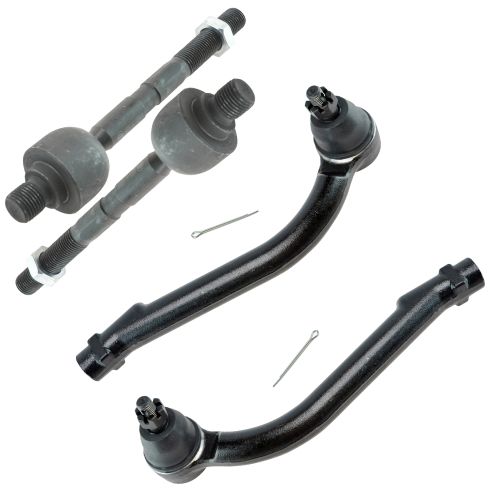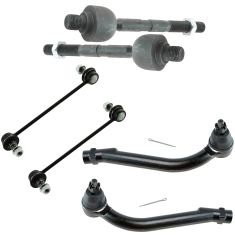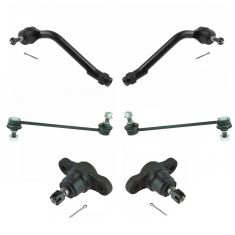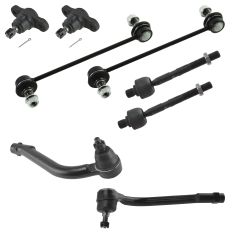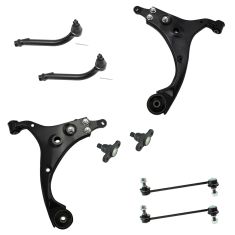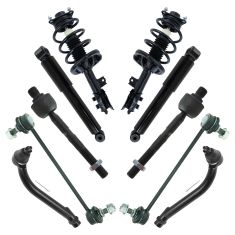Hey, friends. It's Len here at 1A Auto. Today, I'm working on a 2007 Hyundai Elantra. I'm going to show you how to do an inner and an outer tie rod end. It's going to be a very simple job. I want to be the guy that shows you how to do it. If you need these or any other parts, you can always check us out at 1AAuto.com. Thanks.
Okay, so we're going to take off our five lug nuts here with a 21 millimeter socket. There we are. Now, we're going to continue taking off the other four. This one here. Take off our last lug nut, hub cap. So right here, we have our outer tie rod end. We have our knuckle right here, and we have the outer tie rod end nut. The stud for the tie rod comes up through the knuckle just like this, and then the nut holds it on, so we're going to have to remove this nut. It's going to be your prerogative if you want to try to wrench this off with a wrench. Just take it off, or you can just take off this bolt right here, one up there, pop this caliper out of the way, and then you could use something like a socket and whatever you have to remove it, a ratchet or an air gun, whatever you need to do. Okay, so it's up to you. Bolt, bolt, calipers gone, easy peasy, or try to wrench it. Take some time, whatever you want to do.
Located on the other end of the tie rod, there's a jam nut. You're going to want to break this free before you go ahead and do this unless of course you're doing the outer tie rod and the inner tie rod at the same time. Well, actually, I take that back. You should remove this anyway, break it free, because you're going to have to get this boot off of here, in which case you'll have to slide it off. Okay, so disregard what I said about not having to do that. You do have to do that. Pop that for you right now.
Okay. And then come over here, remove this nut right here. And then once we do that, we'll get this off. So here we go. We've got our 14 millimeter. I'm going to remove this. I'm going to remove this right here, and then we'll move along. There's one. We'll do the same to the top one. Let's start this back in real quick just so the caliper can't flop around just in case. Bolt number two, perfect, now we're clear to start getting this caliper off of here. So I opened this up just to make sure that it opens up. Now, I'm going to remove this. Grab my small pry bar. All right, I got my small pry bar. I'm just going to see about getting that out of there.
We're going to take off our tie rod end nut in one second. First, we're going to break this free. This right here is a 22 millimeter, or you could use a 7/8" if you have that, or if you have access to something that looks like this, I would go with these personally. So I'm just going to get it on there. And all I'm going to do, I'm going to break it free. Ready? There we are. Okay. That's spinning. With a little bit of penetrant, that's going to help me get it off down the line here. Just try to work it in while I get my pliers on there.
Feels decent. I noticed that the inner tie rod end was spinning at the same time, so to get that off, we'll have to hold these with some pliers, and we'll zip that nut off. But if you're just doing the outer tie rod end, you don't necessarily need to worry about that. Time to remove our nut up here, 17 millimeter. When we remove this, there is a possibility that the tie rod will swing down, so you want to make sure you don't have your face under there, okay? Super important, safety first, wear some safety glasses. Remove this with your 17 whether you're using a ratchet or an air gun, same size nut. There we are. That off of there. It's a castle nut, slotted. We'll set that aside.
Now, we need to get our outer tie rod end to come down through this knuckle. You can take your big fabulous hammer, whack on the knuckle right there. It might break free. You can use a pickle fork, something along the lines of this. Stick it in there. That might break it free. There's multiple options here. Trying to hit this with a hammer without hitting this might be a little bit of an issue, so let's go with the tool for the job. I'm going to use a pickle fork, or I guess you can call it a tie rod separator, or well, call it whatever you want really.
There we are. So this is your outer tie rod end. We're just going to see if we can get it to break free now. Okay, it doesn't. I'm going to take some locking pliers, put it on the inner tie rod end, and then I'm going to try to turn this off. I got my locking pliers on here. Okay. I brought them right around. They're resting up against our stabilizer. Okay. That's the stabilizer bar. I'm just going to take my pliers, whatever you happen to have, I'm just going to try to turn this outer tie rod end. Yours might turn easier or harder than this. I don't know, but basically, turn it to the left counterclockwise, and get it to come off. Once you get it off, well, you're in a better position than me.
Just want to see if I can get it... Want it to break free. Okay. Maybe I can get it by hand now. Yeah. For a second. Almost there. Here we go. Now, we've removed our left front outer tie rod end. So right here, as I mentioned before, we have a 22 millimeter. I still have my locking pliers on the inner tie rod end. That's going to hold it still for me. I'm going to use a 22 millimeter socket and my air gun. You can use whatever you have access to, but this nut is a 22. You need to remove it from the inner tie rod end. Let's see if it's coming off. Looks like no. All right.
So what I'm going to do now is I'm going to heat it up a little bit. Get it nice and warm and hopefully it'll want to come off at that point. We're going to heat up this nut right here. I'm going to use a little something like a butane torch, MAPP gas, whatever you've got. Maybe you have oxy acetylene torches. You can try that. Just be careful not to cut the tie rod end, at least not yet. Just want to get it nice and hot, and then I'm going to blast it with some more penetrant. I'm going to let that do its thing for a second. Going to heat up all sides here. All right, check to see if it's hot. Just kidding. My penetrant, yeah, it's hot. That's what I thought. You don't want to breathe in any of the smoke if you can avoid it. Here we go, 22. Looks like it's still not working. If you wanted to, you could spray it some more, let it set, or you can go ahead and cut this inner tie rod end. You do you, booboo.
So I'm going to go ahead and try to cut this inner tie rod end just on the other side of the nut there. Okay. I've got this quality tool right here. It's Performance Tool. We sell it right at 1AAuto.com. Let's give it a try. Oh, it's got the little spark deflector. That's always great. Cool. This is going to work awesome. Let's see if this'll come off. There we are. That tool worked great. I definitely recommend it. Take off my locking pliers here.
Right here on the outer portion of this bellows boot, there's a little clamp, okay? It's pretty easy to get to. We're just going to use a couple or a set of needle nose pliers here. See if I can get it to come off the boot. If this clamp isn't in good condition, you can use something like a wire tie. This one right here is in good condition, so I'm going to reuse it. On the inner portion of that bellows boot, there's another clamp. See if I can grab something to show you. What I'm going to do is I'm going to grab a long pry bar. I'm going to press it up against that, and then I'm going to whack it. I want to just knock that off of the power steering rack there, and then I should be able to get the boot off, and we'll get that clamp out of the way.
Here we go. I'm just going to get this right on the clamp. Give it a nice loving bonk. That's my thing, bonk. See if we can get it. Okay. We just need it to come off. Come under here, grab my cutters, whatever I can to get it to break free here. Almost. Here's our clamp. We're going to reuse that. Not really, I'm going to recycle it, even better. So now it's time to get this boot off of here. You can try to twist it, make sure everything's flowing nice and good. Twist and pull. Twist and pull. And there's our bellows boot. That's how you remove your bellows boot.
So I just want to show everybody, we saw this really awesome inner tie rod end tool. This is such a great tool. All you do, take it, you slip it over. You get over this end of the tie rod, and you tighten down these nuts, okay? Once you get them tightened down, so this the squeezing on, I'll show you what to do at that point. So I'm just going to snug them up with my hand here. And then of course, I'm going to use a wrench. It's a 14 millimeter nut. I have a ratchet wrench. It's always a special treat when you get to use something like that. Special treat gone. Just going to make sure this is nice and tight because I want those teeth to really grip into this tie rod end.
Okay, this one again. That feels pretty great. Right here, you'll notice those are 3/8" drive, okay? If you have a 3/8" ratchet that's nice and long with an extension, you can go ahead and use that or without an extension I guess if you're underneath your vehicle. I prefer to use 1/2" drive because that's my longer ratchet and just a little reducer here, okay? I'm just going to pop it on. We'll put this on reverse. I'm just going to give it a little bonk. There we are. That broke free our inner tie rod end.
There are other ways of doing that of course, but we're going to just do it that way. Now, all I'm going to do is I'm going to remove these nuts. Once these are off, we'll get our tool out of here, and we'll be able to take this right out of here by hand. It's going to be really great. Just try to work it off. Great tool right here, 1AAuto.com. Thank you, 1A. See if I can get it. Still a little snug by hand there because it's all lubricated. I'll just use my pliers here. Just get it turning. As you can tell, it's super easy. The tool did its job. It's greased. What am I going to do? There's nothing the tool can do about that. So just take it off, easy peasy. Should be getting close now. There we are, inner tie rod end. There we go. Pop that right off of there.
Here we have our inner tie rod end from our 2007 Hyundai Elantra. I just removed it. Yes, I did have to cut it. I know. Here's our brand new quality 1A Auto part right here. As you can tell, they're approximately the same length, which they should be. I mean, it would be a lot closer obviously if I didn't just cut it, so we'll just go with the assumption it's not cut, and it is the same length because they are. It's manufactured to the right specifications. It comes with a brand new jam nut, super important. Right here, you got your ball and socket, okay? Here's where your bellows boot supposed to ride. It's a nice little groove. They made sure to put that in there for us. We want to make sure we lubricate that when we go to install it. And of course, you got the backside. You can put a little thread locker on there and our little plastic.
Here we have our original outer tie rod end from our 2007 Hyundai Elantra. As you can tell, it's a little bent, supposed to be. Over here, we have our brand new quality 1A Auto part. It's got the same exact bend in it, so that's always good. Comes with a brand new nut, super important, and also a brand new boot. This helps keep the grease in there and keeps the moisture out, okay, super important. Like I said, as you can tell, they got the same bend. Both sealed, okay, that's the way they come. Some people like greasable. Some people like sealed. If it comes sealed, well, it's good forever that way. So there you are. As you can tell, this is a quality part. It matches up exactly with the original, I don't see any reason why this wouldn't be a great part to install into this vehicle, so I'm going to go ahead and do it. If you need this part or any other part, you can always check us out at 1AAuto.com. Thanks.
So here we are. Got our little plastic thing. I'm just going to put it back on there. That's where it was. That's where it wants to be. It's happy there. You can use a little bit of thread locker on here, okay. You definitely don't want to use Never-Seez because you don't want this to come off on its own. It needs to be on there nice and tight. All right. Something else I wanted to mention, your new inner tie rod comes with some grease, okay? This is to put right inside the ball and socket area. I'll show you how to do that right now. Just going to tear this open. Put that aside. We'll recycle the plastic. And here's grease. I'm just going to put it along here. This just goes along the ball and socket. There we are. Helps keep moisture out of there. Keeps it from rusting up. Okay, set that aside.
Now, if you have a vice like this or if you're just strong enough, you can go ahead and move it around. You really don't have to do this portion of it. It's your prerogative if you want to, but you do have to put the grease in there, so I should make sure I specify that. You have to do the grease part, but you don't actually have to do this part as long as you have grease going around the ball and socket so moisture can't get in there and seize it up on you. You're doing all right. So let's grab this, and we'll get it installed in the vehicle.
So I'm going to take off this jam nut. We'll set this aside because we're going to be reusing it. Brand new, love it. Now, like I said, if you want to use a little bit of thread locker, you can go ahead and do that. It's your prerogative. It's your car or somebody's car, but you're working on it. You definitely just don't want it to come out. That's what it's all about. Now, we're just going to try to get this threaded in. Sometimes getting the first thread on there is interesting. There we go. Seems like it's going. I'll get it in as far as I can, and then I'm going to use our quality 1A Auto tool there, the inner tie rod end tool. I'm going to go ahead and tighten it up. We want to make sure it's tight, super important.
Okay, that feels decent. Let's grab our tool. Wipe this down first. Try to get off the majority of the grease on the outside there, so hopefully, our tool can grip on. Let's tighten up these 14 millimeter nuts here. If you notice that your inner tie rod end's too far in behind your subframe, and you have a hard time getting into it, it's pretty easy to do. All you have to do is just go inside your vehicle, turn the wheel, okay? If you end up turning the wheel to the right, it's going to push your left front tie rod out, and you'll be able to get to this easier. So keep that in mind. Just a little tip for you. Could have told you that at the beginning probably, right? Thanks, Len.
Let's see if I can get this on here. Boy, there we are. Okay. Now, when you're tighten this on, you want it to be tight. You want to be nice and snug like I said, but you don't need to actually use your whole force of your whole bar. You don't want to twist your rack inside. That's going to cost you a lot of money. So that feels pretty great right there. Now, I'm just going to loosen these up, and we'll move along. I'm just going to try to loosen this one up. Hopefully, it's going to give me enough play to get this tool moved around. Yeah, there we are. Thanks again inner tie rod tool and 1A.
So I'm going go ahead and take my grease packet that I use to put some lube in here. I'm just going to put it right inside this little ring right here. That's going to make it so when the next person that's doing the alignment, after we're done all this, when they go to turn this inner tie rod end to make their adjustment, the boot's going to be able to slide. If you don't put any lube there, the boot might get caught. It might get twisted as the person's trying to make their adjustment and ruin your boot. So a little bit of lube goes a long way.
Now, we're going to go ahead and grab our boot. We got our little wire tie on here still. I'm just going to go ahead and try to slide it on over. Here we are. I'm just going to wiggle it. Looks like it's close but not close enough. There it is. Oh, yeah. Oh, yeah. Got our wire tie that we can see it. All right. Now, I'm just going to pull that tight. I like to do that with some a long nose pliers. Just grab it, give a little twist, so it doesn't sound like it's clicking anymore. It's always good habit to trim off whatever you're not using. Perfect.
So now, we're going to do the boot on the outside of this or the clamp on the outside of the boot. I'm just going to pull it back down to where it's supposed to go. See if I can grab onto it. There it is. We've got our clamp. Going to put them on my long nose pliers. Try to get it over the boot. If your clamp doesn't go over, or it's broken, or it's rusted, or just plain old garbage, you can go ahead and use a wire tie on it. Doesn't have to be airtight so much as just try to keep the moisture out of there. That's the important part of it, okay? Here we go. We're getting there now. There we are. We've got that on there. Still spins. That feels great.
Now, we can go ahead and put on our jam nut and our outer tie rod end. I like to use a little bit of never seize on here. It's your prerogative if you want to or not. Just helps make sure everything moves nice and free, your jam nut and all that for when the person's doing the alignment or if some day you have to do other adjustments. We have our brand new jam nut. Just going to put it on here quite a bit, and then we can bring it back to meet up with the tie rod once we get it lined up to where we need it, okay?
I'm just going to turn this on. If you happen to have counted when you took it off, that's awesome. If you didn't and you just want to kind of try to eyeball it... Basically, if you didn't move your knuckle at all when you were moving things around here, it should line up with that hole right there, okay? We remember the outer tie rod end stud faced up and went up through the knuckle, so that's the way I'm going to put it back in. There it is. We have our nut. Just going to put this right on here. All right. Now, we'll tighten that up so it's nice and snug, and then we'll torque it down, and we'll put our cotter pin through. So I'm going to go ahead and torque this down. My new nut is a 16 millimeter. I'm going to go 25 foot-pounds with my torque wrench. There we are. I'm just going to hit it one more time. That feels great. Now, I'm going to put the cotter pin through. That's just going to ensure that this nut can't loosen up and come off. We don't want that coming off obviously.
So we've got a brand new cotter pin, comes with the outer tie rod end by the way. I'm sure you saw it in your packaging. Now, I'm just going to try to peen that up. Going to grab my, oh, whatever you want really. Even use your fingers if you're strong enough. And all I'm going to do is just try to bend it. Here we are. Give it a couple bonks. There we are. That cotter pin will not come out, and therefore, this nut will not come off. So now, it's time to snug up this jam nut right here. What this does is it basically ensures that the inner tie rod can't spin and completely loosen up as you're turning and hitting bumps and stuff. And then of course, your outer tie rod end would come unscrewed from that. So what it does is it jams it in, jam nut.
I'm just going to bottom it out just like that. For this application, I'm going to use a 21 millimeter. It's a little smaller than the original. That doesn't matter. Give it a little tweak. Now, I'm just going to go ahead and straighten out the outer tie rod end so it's sitting pretty much straight up and down. And there we go. Now, we can go ahead, and we'll get our caliper back on. We'll get this all situated, and off we go. Okay, slide that right on there. We've got our two caliper two bracket bolts. You can use thread locker if you'd like. It's your prerogative. Just don't use Never-Seez please. Get that started in. Get this one started in. Once they're both started, we'll go ahead and tighten them up. There is a torque specification, so all I'm going to do is bottom it out. There we are. Let's grab the torque spec.
Okay, so now it's time to go ahead and torque these down. I just want to let you know that the caliper slider heads themselves is a 17, okay? So if you find it that the caliper slider's spinning when you're trying to torque or tighten it down, you can just go ahead and use the 17, and it should be fine. You can drop it on the floor. Likes it there. And one more time. Sometimes, your wrench might be a little bit thick like mine, so if that's the case, well, you're going to have to figure it out. Could also try to use some locking pliers in there if they're a little thinner for you. Okay. Going to hit it one more time here. Here we are. So 23, 23. Time to get the wheel back up on here. Just going to go ahead and lift it up. Center cover, hub cap, whatever you want to call it.
We're just going to bottom these out with our 21 millimeter socket and our long ratchet. Once they're all bottomed out, we'll bring it down on the ground and torque them up. So now we're going go ahead and torque these down with our 21 millimeter to 80 foot-pounds. We're going to do a star pattern. Okay, one here, here, here, here, here. I'm just going to go around.
Thanks for watching. Visit 1AAuto.com for quality auto parts shipped to your door, the place for DIY auto repair. And if you enjoyed this video, please click the subscribe button.
